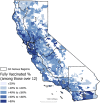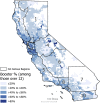Neighborhood-level COVID vaccination and booster disparities: A population-level analysis across California
- PMID: 36873265
- PMCID: PMC9982676
- DOI: 10.1016/j.ssmph.2023.101366
Neighborhood-level COVID vaccination and booster disparities: A population-level analysis across California
Abstract
Objectives: To describe vaccine and booster uptake by neighborhood-level factors in California.
Methods: We examined trends in COVID-19 vaccination up to September 21, 2021, and boosters up to March 29, 2022 using data from the California Department of Public Health. Quasi-Poisson regression was used to model the association between neighborhood-level factors and fully vaccinated and boosted among ZIP codes. Sub-analyses on booster rates were compared among the 10 census regions.
Results: In a minimally adjusted model, a higher proportion of Black residents was associated with lower vaccination (HR = 0.97; 95%CI: 0.96-0.98). However, in a fully adjusted model, proportion of Black, Hispanic/Latinx, and Asian residents were associated with higher vaccination rates (HR = 1.02; 95%CI: 1.01-1.03 for all). The strongest predictor of low vaccine coverage was disability (HR = 0.89; 95%CI: 0.86-0.91). Similar trends persisted for booster doses. Factors associated with booster coverage varied by region.
Conclusions: Examining neighborhood-level factors associated with COVID-19 vaccination and booster rates uncovered significant variation within the large and geographically and demographically diverse state of California. Equity-based approaches to vaccination must ensure a robust consideration of multiple social determinants of health.
Keywords: ACS, American Community Survey; CDPH, California Department of Public Health; COVID-19; COVID-19, Coronavirus Disease 2019; Health disparities; LEP, Limited English Proficiency; Neighborhood; Population health; SDOH, Social Determinants of Health; Social determinants of health; UCSF, University of California, San Francisco; VEM, Vaccine Equity Metric; Vaccination; ZCTA, Zip Code Tabulation Area.
© 2023 The Authors.
Conflict of interest statement
None to declare.
Figures




Similar articles
-
Inequities in COVID-19 vaccine and booster coverage across Massachusetts ZIP codes after the emergence of Omicron: A population-based cross-sectional study.PLoS Med. 2023 Jan 31;20(1):e1004167. doi: 10.1371/journal.pmed.1004167. eCollection 2023 Jan. PLoS Med. 2023. PMID: 36719864 Free PMC article.
-
Quantifying inequities in COVID-19 vaccine distribution over time by social vulnerability, race and ethnicity, and location: A population-level analysis in St. Louis and Kansas City, Missouri.PLoS Med. 2022 Aug 26;19(8):e1004048. doi: 10.1371/journal.pmed.1004048. eCollection 2022 Aug. PLoS Med. 2022. PMID: 36026527 Free PMC article.
-
Neighborhood Factors Associated with COVID-19 Cases in California.J Racial Ethn Health Disparities. 2023 Dec;10(6):2653-2662. doi: 10.1007/s40615-022-01443-y. Epub 2022 Nov 14. J Racial Ethn Health Disparities. 2023. PMID: 36376642 Free PMC article.
-
Use of the Improvement Index to Evaluate Equitable COVID-19 Vaccine Allocation in the San Francisco Bay Area.AJPM Focus. 2023 Jun;2(2):100075. doi: 10.1016/j.focus.2023.100075. Epub 2023 Feb 4. AJPM Focus. 2023. PMID: 36776788 Free PMC article.
-
COVID-19 Vaccination Dynamics in the US: Coverage Velocity and Carrying Capacity Based on Socio-demographic Vulnerability Indices in California.J Immigr Minor Health. 2022 Feb;24(1):18-30. doi: 10.1007/s10903-021-01308-2. Epub 2021 Nov 19. J Immigr Minor Health. 2022. PMID: 34797451 Free PMC article.
Cited by
-
Building an agile state-wide research infrastructure to address COVID-19 and emerging threats: insights from an equity-centered public health and academic collaboration in California.Front Public Health. 2025 Jul 8;13:1549326. doi: 10.3389/fpubh.2025.1549326. eCollection 2025. Front Public Health. 2025. PMID: 40697849 Free PMC article.
-
Fostering public health and academic partnerships during and beyond a public health emergency: lessons learned from COVID-19.Am J Epidemiol. 2025 Jun 3;194(6):1482-1484. doi: 10.1093/aje/kwaf007. Am J Epidemiol. 2025. PMID: 39825492 Free PMC article. No abstract available.
References
-
- Association of University Centers on Disabilities . 2021. COVID-19 vaccination challenges for people with disabilities [press release]. AUCD.https://www.aucd.org/docs/AUCD_COVID-19%20Vaccination%20Challenges%20for...
-
- Barry V., Dasgupta S., Weller D.L., Kriss J.L., Cadwell B.L., Rose C.…Black C.L. Patterns in COVID-19 vaccination coverage, by social vulnerability and urbanicity – United States, december 14, 2020-may 1, 2021. MMWR Morb Mortal Wkly Rep. 2021;70(22):818–824. doi: 10.15585/mmwr.mm7022e1. - DOI - PMC - PubMed
LinkOut - more resources
Full Text Sources
Miscellaneous

